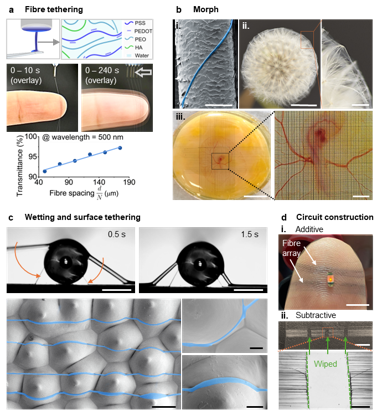We developed a fibre biofabrication method, Orbital Spinning to make adaptive and eco-friendly sensors that can be directly and imperceptibly printed onto a wide range of biological surfaces, whether that’s a finger or a flower petal.
The fibres, at least 50 times smaller than a human hair, is spun to follow the anatomy of different shapes, at both the micro and macro scale, without the need for image recognition. Such 'Physically Intelligent' biofabrication technique opens up a whole different angle in terms of how sustainable electronics and sensors can be made and upgraded, anywhere and anytime without centralised facilities.
This work is part of our vision/ Perspective on how biofabrication could contribute to Sustainable Bioelectronics, ETextiles and System EngineeringBiology.
Link to News at University of Cambridge
We used a 3D printing technique, also known as additive manufacturing, to make composite electronic fibres, each 100 times thinner than a human hair, creating sensors beyond the capabilities of conventional film-based devices. Such a room temperature deposition and patterning of circuitry process circumnavigates the need for conventional energy- and time-intensive fabrication of functional materials. Using this technique we made non-contact, wearable, portable respiratory sensors. These printed sensors are high-sensitivity, low-cost and can be attached to a mobile phone to collect breath pattern information, sound and images at the same time. The developed fibre sensors were used to test the amount of breath moisture leaked through face coverings, for respiratory conditions such as normal breathing, rapid breathing, and simulated coughing. The fibre sensors significantly outperformed comparable commercial sensors, especially in monitoring rapid breathing, which replicates shortness of breath.
In addition to the respiratory sensors, the printing technique can also be used to make biocompatible fibres of a similar dimension to biological cells, which enables them to guide cell movements and ‘feel’ this dynamic process as electrical signals. Also, the fibres are so tiny that they are invisible to the naked eye, so when they are used to connect small electronic elements in 3D, it would seem that the electronics are ‘floating’ in mid-air.
https://doi.org/10.1126/sciadv.aba0931
Using a new fibre production method called dynamic near-field electrospinning (dNFES), we have developed a bio-inspired acoustic sensor that ‘feels’ its environment in a similar way to how a spider feels acoustic vibrations in its web. The electronic device, which detects sound levels, makes use of a polymer nanofibre mesh to generate an electric charge when activated. The result is a self-powered sensor of high sensitivity and transparency, with a broad audible frequency bandwidth, making it potentially suitable for use in a number of applications, ranging from environmental detection through to biomedical diagnostics and the Internet of Things (IoT).
https://doi.org/10.1002/smll.202000581



